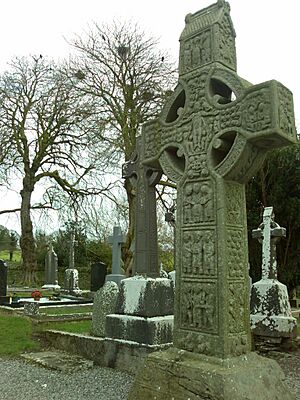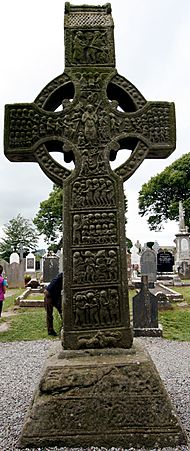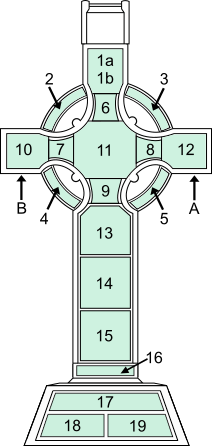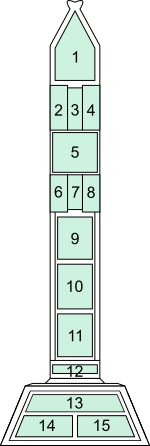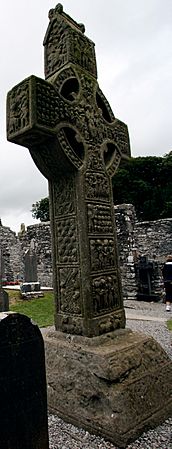Muiredach's High Cross facts for kids
Muiredach's High Cross is an amazing stone cross from around the 9th or 10th century. You can find it at the old monastery site of Monasterboice in County Louth, Ireland. There are two other tall crosses at Monasterboice, but Muiredach's Cross is also called the South Cross by local people. Many consider it the most impressive example of early Irish stone art. Some even say the crosses at Monasterboice are Ireland's greatest gift to European sculpture! Recently, people have worried about the cross's condition. They think it might need to be moved indoors to protect it from the weather.
Contents
What are High Crosses in Ireland?
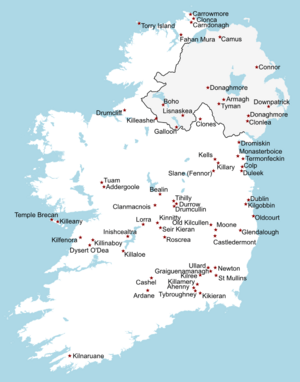
Irish high crosses are famous symbols of early medieval Ireland. You usually find them at old church sites. Some are plain, while others are beautifully decorated. High crosses had many uses. They were important for church ceremonies and acted as symbols. They also marked safe areas around a church and became meeting points for markets.
The most famous Irish high crosses are at Durrow Abbey, the Abbey of Kells, and Monasterboice. These crosses are covered with carvings of stories from the Bible. Experts think they were inspired by art from ancient Rome. These "classic" high crosses have the largest collection of Bible sculptures in Europe from that time!
The carved scenes were probably painted with bright colors long ago, but no paint remains today. On these crosses, the east side often shows scenes from the Old Testament. The west side usually shows scenes from the New Testament.
The oldest Irish high crosses, found at Kinnity, were made between 846 and 862 CE. Muiredach's Cross and the Cross of the Scriptures at Clonmacnoise were made around 900–920 CE. High crosses likely started as stone versions of decorated wooden or metal crosses. The large stone crosses we see today are the final stage of their development. Earlier ones were probably smaller and made of wood with bronze decorations. Irish high crosses are thought to have come from stone crosses in Britain, which became popular in the 8th century.

Muiredach's High Cross is one of three tall crosses at Monasterboice. This name comes from the Irish Mainistir Bhuithe, meaning "Buithe's monastery." The monastery was supposedly founded in the 6th century by St Buithe. It is most famous for its high crosses from the 9th and 10th centuries. These crosses are all made of sandstone and are called the North, West, and South Crosses. We don't know for sure if they are still in their original spots.
The South Cross is known as Muiredach's Cross because of a special message carved at the bottom of its west side. This message says: ÓR DO MUIREDACH LAS NDERNAD IN CHROS. This means "a prayer for Muiredach who had this cross made." People believe this Muiredach was probably Muiredach mac Domhnall, a famous abbot (leader) of the monastery who died in 923. He was also an important church leader in Armagh. There was another abbot named Muiredach who died in 844, and even a king named Muiredach mac Cathail who died in 867. So, the exact Muiredach is a bit of a mystery!
The cross stands about 19 feet (5.8 m) tall, including its base. The base itself is about 2 feet 3 inches (0.69 m) high. The cross is made of yellow sandstone. The main part of the cross was carved from one huge block of stone. The base and the capstone (the stone on top) were carved separately. The capstone looks like a small house with a sloped roof. These house-shaped capstones might represent special containers for holy items, called reliquaries.
Every part of the cross is covered in carved panels. The carvings are still in great shape, but they would have had even finer details when they were new. Even now, you can clearly see details about clothes, weapons, and other objects. Most of the carvings show Bible stories, but some also have cool geometric shapes and woven patterns.
An archaeologist named Robert Alexander Stewart Macalister counted 124 figures carved on the cross. Most of them are wearing clothes from that time period. Only one figure, Goliath, wears a conical helmet. Many figures have no facial hair, but some have very long moustaches that hang down. Only a few figures, like Adam, Cain, Moses, and Saul, have beards. Macalister thought the artist was especially good at the geometric and abstract patterns. The ring around the cross's head has 17 different patterns! These patterns include spirals, woven designs, and key-patterns.
Protecting the Cross
People have recently become worried about keeping the cross safe. In 2004, Barry McGahon, who leads the Monasterboice Tour Guides, said the cross wasn't well protected. He suggested putting a railing around it to keep people from touching it. McGahon also noticed that the cross was taking longer to dry after rain, as if water was soaking in. He worried that acid rain and air pollution from a new motorway nearby would harm the cross. In 2008, Peter Harbison, a professor of archaeology, suggested moving the crosses indoors to protect them from the weather. He said that if they stay outside, they will continue to decay because sandstone breaks down easily.
Becoming a UNESCO World Heritage Site?
Around 2008, Professor Harbison said that the crosses at Monasterboice could be seen as Ireland's greatest gift to European sculpture. In April 2009, The Irish Times newspaper reported that the Government of Ireland was planning to suggest Monasterboice, among other places, to UNESCO. This means it could become a World Heritage Site, which would help protect it even more.
What the Panels Show
East Face Carvings
- Panel 1. This panel shows two holy hermits, Anthony and Paul of Thebes. They are holding a loaf of bread, and a raven is sitting nearby.
- Panel 7. This panel shows The Last Judgement. It has over 45 figures! In the middle, Jesus stands, holding a flowery staff and the Cross of the Resurrection. A bird, possibly a phoenix (a symbol of new life), is on Jesus's head. At his feet is a small kneeling figure with an open book, likely an angel with the Book of Life. To Jesus's right, King David plays a harp, with the Holy Spirit (a dove) resting on it. Behind him, angels play music. To Jesus's left are the Lost Souls, being chased away by a devilish creature.
- Panel 8. This panel shows Archangel Michael, the Devil, and a human. Michael is weighing a human soul on a scale. The Devil is lying below, trying to pull down the empty side of the scale to cheat! Michael also holds a staff and is pushing it into the Devil's head. This scene is unique and not found on other Irish high crosses.
- Panel 9. This panel shows the Adoration of the Magi. Usually, there are three Magi (wise men), but here there are four. They are being led by an old, bearded Saint Joseph. Above Jesus's head is the Star of Bethlehem.
- Panel 10. This panel shows Moses getting water from a rock. Moses stands with his staff in front of thirsty Israelites, and water gushes from a hole. This scene was chosen because it reminds us that Christ is like the spiritual rock, giving us living water.
- Panel 11. This panel shows the battle between David and Goliath. David holds a sling, showing he has already thrown the stone. Goliath is on his knees, with his hand to his forehead, showing he's been hit. He wears a helmet and carries a shield and dagger. To the left, King Saul sits, drinking from a horn.
- Panel 12. This is a double panel with two scenes. The left side shows Adam and Eve under the forbidden tree, which is full of fruit. The serpent is coiled around the tree, whispering to Eve, who is giving the apple to Adam. This scene explains how sin entered the world. The right side shows the first murder: Cain and Abel. Cain, an older man, grabs Abel, a young man, and hits him with a cleaver.
- Panel 13. This panel shows two animals playing, possibly lions.
Panels A and B
These panels are on the underside of the cross's arms.
- Panel B. This panel shows a hand surrounded by clouds. This represents the Hand of God, a Christian symbol used for a long time. Before the 12th century, artists usually showed God as a hand coming from the clouds. This scene has no connection to the other stories on the cross. Since it's on the underside, it looks like the Hand of God is reaching out to anyone standing below.
West Face Carvings
- Panel 1a. This panel shows Moses on Mount Sinai, with Aaron and Hur helping him hold up his hands.
- Panel 11. This panel shows the Crucifixion of Christ. Jesus is on the cross, fully clothed, which was common in art at that time. His arms are stretched out straight. Two figures, one with a lance and one with a sponge, are on either side of Christ. Two round shapes between them and Christ might be the sun and moon, showing the darkness during the Crucifixion. A bird at the foot of the cross might symbolize resurrection or peace. Two smaller figures, likely the Virgin Mary and John, are also shown.
- Panel 13. This panel likely shows the ascending Christ giving his final instructions to his Apostles. Christ is seated, and he gives a scroll to the figure on his left and a book to the figure on his right. The figure on the right is probably John, as an eagle (his symbol) is shown above his head.
- Panel 14. This panel shows three figures. The middle figure has his hand raised in blessing. The figure on the left is touching the side of the central figure. This panel is thought to show the Incredulity of Thomas ("Doubting Thomas"), which is quite rare on Irish crosses.
- Panel 15. This panel shows three men and is thought to represent the arrest of Christ in the garden of Gethsemane. Christ is in the middle, holding a staff, and being arrested by two men with military gear. A similar scene is on the Cross of King Flann at Clonmacnois.
North Face Carvings
- Panel 5. It's not clear what this panel shows. It has three angels, a seated figure holding something unclear, and two other figures holding rods. Some think it might be the Scourging of Christ, but this is just a guess.
South Face Carvings
- Panel 1. This panel shows a horseman, and above him, a very worn pattern of spirals. Some think it might be one of the mysterious riders from the Book of Revelation.
- Panel 5. This panel shows Pilate washing his hands. The Gospel of Matthew says that before sentencing Jesus to death, Pilate washed his hands in front of the crowd, saying he was innocent of Jesus's blood.
- Panel 9. This panel shows a coiling plant. In six of its coils, there's an animal kicking its back legs. The legs of the middle two animals twist together to form a pattern. At the top, two birds are feeding.
See also
 In Spanish: Cruz de Muiredach para niños
In Spanish: Cruz de Muiredach para niños


